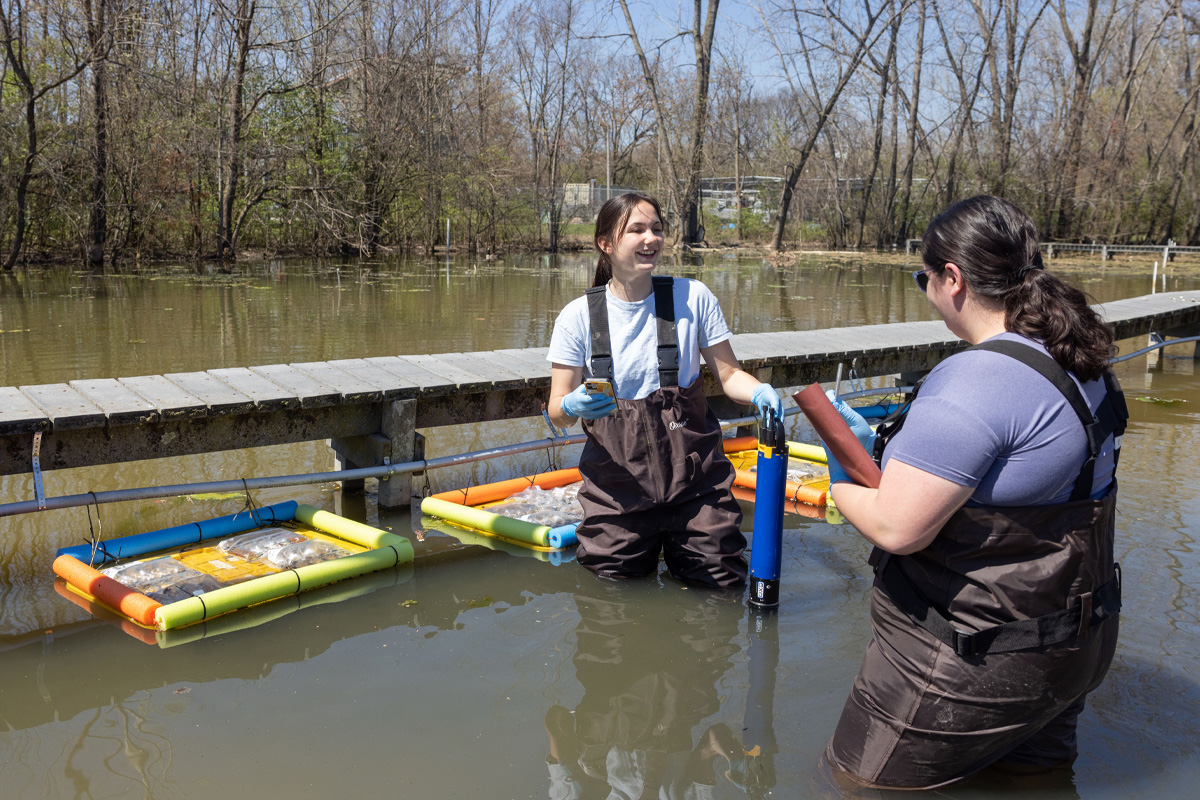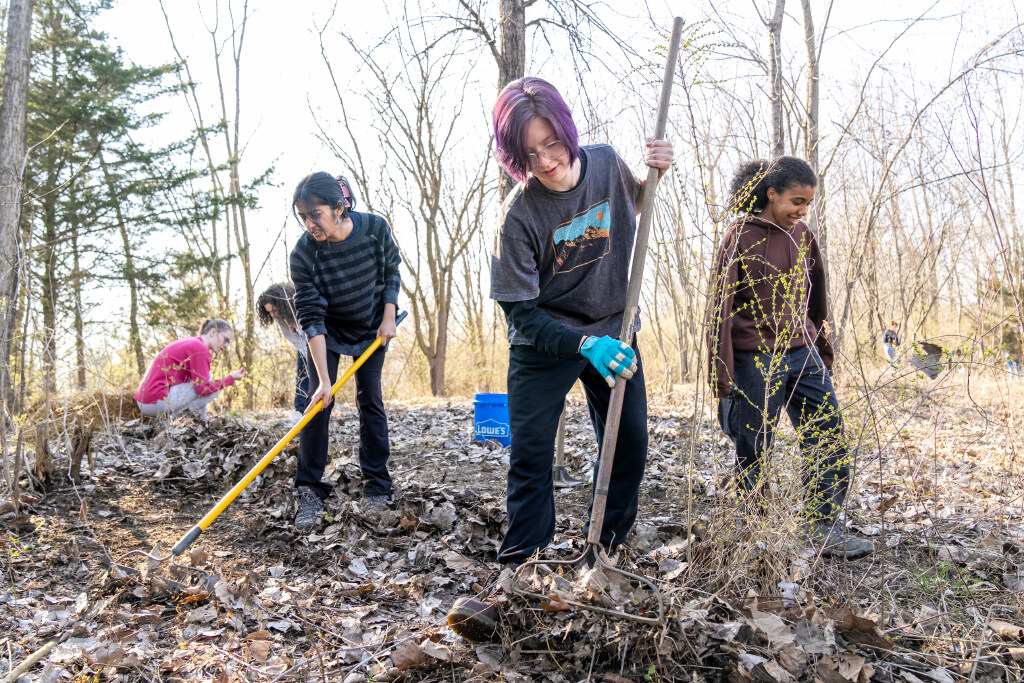7 ways our students create a more sustainable world
Students are restoring the Olentangy River bank, building a solar-powered racecar and so much more.

Ohio State students are using the university’s research opportunities, student organizations and community connections to create a more sustainable world.
This work is important to protecting our environment and creating a brighter future for generations ahead. Let’s look at seven ways Ohio State students are building the type of world they’d like to live in.
Improving Ohio’s water quality
Mary Kate Rinderle
Major: Environmental Science with a specialization in Water Science
H2Ohio: Mary Kate became immersed in Ohio’s water quality efforts last spring through her internship with H2Ohio, a program designed to restore the state’s wetlands. Wetlands improve water quality and cut down on harmful algal blooms by filtering out pollutants from waterways. They also slow the movement of water, decreasing erosion of stream banks. Her internship took her to H2Ohio’s 113 wetland creation and restoration projects, where she worked directly with project leaders. She also shadowed the LEARN team (Lake Erie and Aquatic Research Network) to collect data at completed wetlands to understand their effectiveness.
Ohio State’s Stone Laboratory: Following her internship, Mary Kate became a research fellow at Stone Laboratory, conducting independent research on Lake Erie’s limnology – the lake’s biological, chemical and physical features. Working with Justin Chaffin, senior research coordinator, she designed and conducted experiments to investigate phytoplankton growth rates. Mary Kate is currently working on a manuscript for academic publication.
“I had a blast living on an island for two months. It was a beautiful place to be, and there was always something to do. Living on the lake really fueled my passion for water sciences.”
Transformative experiences: “Being able to contrast two very different job experiences was very formative for me. Both Ohio State and H2Ohio are working to make our environment cleaner, safer and healthier. H2Ohio wants us to be conscious of how we are altering landscapes and recognize the impact that such action can have on our waterways, even hundreds of years down the line. In this way, H2Ohio advocates for the sustainable use of our lands and the water resources that are impacted by wetland destruction.”
Exploring life as a sustainability professional
Aurora Ellis
Major: Environmental policy and decision-making
Shaping her career: Aurora’s interest in sustainability dates back to third grade, when she participated in a water-quality research program in Atlanta. She chose Ohio State because of its opportunities in the area. As she looks to graduation, she credits her experiences here with shaping her vision of being a lawyer for the Environmental Protection Agency. “All the different experiences I’ve had at Ohio State have helped me decide what direction to take with my career,” she said.
Real-world experience through internships: At Ohio State’s Sustainability Institute, Aurora’s been able to develop her abilities as a marketing-communications professional. At U.S. Compliance, an environmental compliance firm, she had a chance to experience how businesses work to establish and meet regulations. And at the U.S. International Development Finance Corp., as an environmental impact analysis intern, she experienced the policy-making side of government.
Working with professionals: Most recently, Aurora was one of nine Ohio State students who participated in the Midwest Climate Summit. “It was an empowering experience. I was able to work side-by-side with professionals who’ve been working in the field for 30 or 40 years. It really gave me the confidence that I can take all I’ve learned into the real world and be a success.”

Building solar-powered Buckeye racers
Samantha Turner
Major: Mechanical Engineering
Racing toward a green future: Samantha is the Operations Director for Buckeye Solar Racing, a student-led team that is designing and building a solar-powered vehicle to race in national competitions. Working out of the Center for Automotive Research, the team plans to unveil its vehicle, Farasi II, ahead of this summer’s Formula Sun Grand Prix in Topeka, Kansas. Dozens of students from a variety of majors have joined the team since it formed in 2021.
“We aim to expose students, no matter their level of previous experience, to real-world engineering and business challenges, creating the next generation of renewable energy leaders,” Samantha says.
A team effort: Buckeye Solar Racing salvaged a few parts from an old car donated by Western Michigan University’s solar racing team. But that was only the beginning of their efforts; they’re building the vehicle from the ground up, including the chassis, brakes, steering system and more. One team is devoted to installing and optimizing the array of solar panels and batteries that make the car move, while ensuring all electrical and software components work properly. A separate team is focused on aerodynamics, using simulations and wind tunnel testing to make the vehicle faster — it is a racecar, after all.
Creating the green infrastructure we need
Cade Capper
Major: Forestry, Fisheries, and Wildlife
Two problems, one solution: Cade’s research explores how green infrastructure can help with two separate problems: dwindling monarch butterfly populations and pollution in local rivers. He studied special rain gardens built by the City of Columbus – called bioretention cells – that filter pollutants out of stormwater, improving the water quality of tributaries, such as the Olentangy River. The gardens also include milkweed plants where monarchs can lay their eggs.
“This is important because monarchs are losing a great deal of their milkweed habitat to agricultural and urban expansion, causing drastic declines in their populations,” he says.
Looking forward: Cade analyzed the results and found that monarchs lay their eggs in bioretention cells at similar rates as they do in natural milkweed patches. His work shows that these rain gardens can serve well as a substitute habitat for monarchs while bringing other environmental benefits. And it could have a broader impact still. The city asked him for a report on his work, which will help inform future green infrastructure projects as part of the Blueprint Columbus initiative.

Restoring the Olentangy River bank
Eva Freeman and Darienne Purtz
Majors: Environmental science, specializing in ecosystem restoration.
Getting their hands dirty: As members of Ohio State’s chapter of the Society for Ecological Restoration (SER), Eva and Darienne spent many hours restoring the habitat along the banks of the Olentangy River. SER promotes returning ecosystems to their natural state while inviting students to take what they learn from the classroom to actual sites.
Eva, Darienne and other SER members practice adaptive management of the Olentangy River Bank and Wetlands Center grounds. That can include removal of invasive plant species or native seed plantings. “We’ll use hand saws and loppers to remove invasives, like Amur honeysuckle, ailanthus, and callery pear, and apply herbicide on the cut stumps. Invasive sweeps like this are important to open up space for native species to grow and to decrease competition for them to thrive,” Eva says.
A diverse student organization: “A great thing about our organization is we have members who major in everything from psychology to English education. Getting involved with SER was the best way to get more experience in the field and bond with other students who have shared interests. It gives students with a passion for actively helping the planet a community where they can diversify their thoughts on restoration and the natural world,” Darienne says.
Entrepreneurship for sustainability
Parker Haskett
Major: Information systems, Fisher College of Business
Best of student startups: Parker is part of a team that’s created the startup business Mycolite Solutions, an effort focused on developing a plastic-eating fungus that can help eliminate waste from recycling. The team was one of six honorees in the 2022 Best of Student Startups competition hosted by the Keenan Center for Entrepreneurship. “We wanted to tackle a meaningful problem with a unique solution, but it was John (Chapman) who produced the idea of composting plastics with fungi. Once we put in a little research, it seemed like quite a cool idea. Building a startup is very exciting, and it feels like intense real-world problem-solving,” Haskett said.
Entrepreneurial culture: The Mycolite team met as part of Ohio State’s Entrepreneurship & Innovation Scholars program, and is comprised of a group of students with different interest areas. Team members include Parker, John Chapman (economics), Zayne Jaber (finance and economics), Sanyam Shekhawat (information systems) and Sidney McLean (computer science).
Meeting a crucial need: “We envision launching a pilot program at Ohio State to help reduce our own plastic waste here,” Parker said. “From there, we want to take our proof of concept and partner with the Solid Waste Authority of Central Ohio (SWACO) to scale up our process to accommodate all of Ohio and eventually the entire United States.”

Driving campus Zero Waste goals
Maya Hammond
Major: Environment, economy, development and sustainability, specializing in business and sustainability.
Campuswide efforts: Maya is a Zero Waste intern for Ohio State’s Facilities Operations and Development (FOD) department. Her job is to help the campus achieve Zero Waste with a goal of diverting 90% of waste by 2025.
Digging in: Maya’s work on campus includes a variety of jobs, such as helping to implement and track the success of compositing programs throughout the Columbus Campus, sorting waste to help Ohio Stadium continue its Zero Waste efforts, or participating in massive waste sorts (several thousand pounds in one week) to see exactly what people were throwing away on campus. Working directly with Ohio State’s sustainability team gives Maya a firsthand view of what it’s like to institute green practices for a large-scale corporation, which is exactly what she’s hoping to do in her career.
Having an impact: Not only does her work impact the environment directly, but Maya helps influence the habits of others. She is regularly a guest speaker for Ohio State clubs, talking about the Zero Waste program and giving advice on what can be recycled and composted and why. She also facilitates trainings for compost volunteers.
A passion for the work: “I would say I’m a big environmentalist not because I’m obsessed with nature, which I am, but because I understand if I want to enjoy something like a football game and eat some food, I need the Earth and its resources to do that. It’s common sense. That’s why I care. Protecting the environment is the undisputed most important topic there is.”